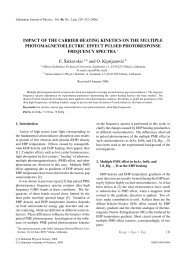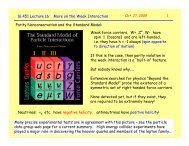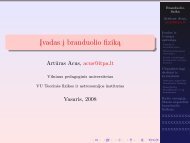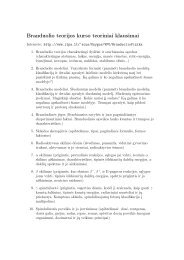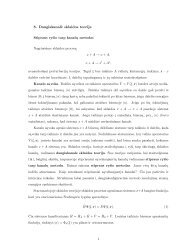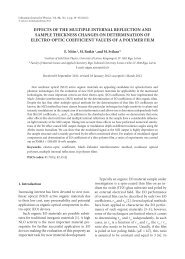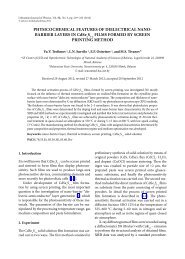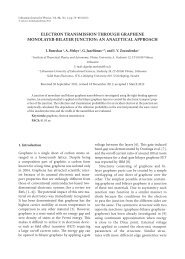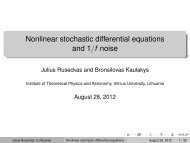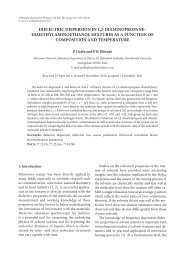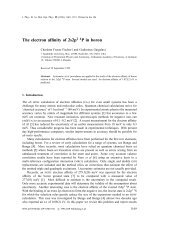Multi-component slow light. Exchange of orbital angular momentum ...
Multi-component slow light. Exchange of orbital angular momentum ...
Multi-component slow light. Exchange of orbital angular momentum ...
You also want an ePaper? Increase the reach of your titles
YUMPU automatically turns print PDFs into web optimized ePapers that Google loves.
<strong>Multi</strong>-<strong>component</strong> <strong>slow</strong> <strong>light</strong>.<br />
<strong>Exchange</strong> <strong>of</strong> <strong>orbital</strong> <strong>angular</strong> <strong>momentum</strong> between<br />
<strong>slow</strong> <strong>light</strong> and cold atoms<br />
Julius Ruseckas<br />
Institute <strong>of</strong> Theoretical Physics and Astronomy, Vilnius University, Lithuania<br />
May 3, 2011<br />
J. Ruseckas (Lithuania) <strong>Multi</strong>-<strong>component</strong> <strong>slow</strong> <strong>light</strong> May 3, 2011 1 / 36
Quantum Optics Group<br />
http://www.itpa.lt/quantumgroup/<br />
J. Ruseckas (Lithuania) <strong>Multi</strong>-<strong>component</strong> <strong>slow</strong> <strong>light</strong> May 3, 2011 2 / 36
Outline<br />
1 Introduction<br />
Slow <strong>light</strong><br />
Storing <strong>of</strong> <strong>slow</strong> <strong>light</strong><br />
2 Slow and stored <strong>light</strong> with <strong>orbital</strong> <strong>angular</strong> <strong>momentum</strong><br />
3 <strong>Multi</strong><strong>component</strong> <strong>slow</strong> <strong>light</strong><br />
Neutrino-type oscillations for <strong>slow</strong> <strong>light</strong><br />
Dirac equation for <strong>slow</strong> <strong>light</strong><br />
Transfer <strong>of</strong> <strong>orbital</strong> <strong>angular</strong> <strong>momentum</strong><br />
4 Summary<br />
J. Ruseckas (Lithuania) <strong>Multi</strong>-<strong>component</strong> <strong>slow</strong> <strong>light</strong> May 3, 2011 3 / 36
Outline<br />
1 Introduction<br />
Slow <strong>light</strong><br />
Storing <strong>of</strong> <strong>slow</strong> <strong>light</strong><br />
2 Slow and stored <strong>light</strong> with <strong>orbital</strong> <strong>angular</strong> <strong>momentum</strong><br />
3 <strong>Multi</strong><strong>component</strong> <strong>slow</strong> <strong>light</strong><br />
Neutrino-type oscillations for <strong>slow</strong> <strong>light</strong><br />
Dirac equation for <strong>slow</strong> <strong>light</strong><br />
Transfer <strong>of</strong> <strong>orbital</strong> <strong>angular</strong> <strong>momentum</strong><br />
4 Summary<br />
J. Ruseckas (Lithuania) <strong>Multi</strong>-<strong>component</strong> <strong>slow</strong> <strong>light</strong> May 3, 2011 3 / 36
Outline<br />
1 Introduction<br />
Slow <strong>light</strong><br />
Storing <strong>of</strong> <strong>slow</strong> <strong>light</strong><br />
2 Slow and stored <strong>light</strong> with <strong>orbital</strong> <strong>angular</strong> <strong>momentum</strong><br />
3 <strong>Multi</strong><strong>component</strong> <strong>slow</strong> <strong>light</strong><br />
Neutrino-type oscillations for <strong>slow</strong> <strong>light</strong><br />
Dirac equation for <strong>slow</strong> <strong>light</strong><br />
Transfer <strong>of</strong> <strong>orbital</strong> <strong>angular</strong> <strong>momentum</strong><br />
4 Summary<br />
J. Ruseckas (Lithuania) <strong>Multi</strong>-<strong>component</strong> <strong>slow</strong> <strong>light</strong> May 3, 2011 3 / 36
Outline<br />
1 Introduction<br />
Slow <strong>light</strong><br />
Storing <strong>of</strong> <strong>slow</strong> <strong>light</strong><br />
2 Slow and stored <strong>light</strong> with <strong>orbital</strong> <strong>angular</strong> <strong>momentum</strong><br />
3 <strong>Multi</strong><strong>component</strong> <strong>slow</strong> <strong>light</strong><br />
Neutrino-type oscillations for <strong>slow</strong> <strong>light</strong><br />
Dirac equation for <strong>slow</strong> <strong>light</strong><br />
Transfer <strong>of</strong> <strong>orbital</strong> <strong>angular</strong> <strong>momentum</strong><br />
4 Summary<br />
J. Ruseckas (Lithuania) <strong>Multi</strong>-<strong>component</strong> <strong>slow</strong> <strong>light</strong> May 3, 2011 3 / 36
Slow <strong>light</strong><br />
J. Ruseckas (Lithuania) <strong>Multi</strong>-<strong>component</strong> <strong>slow</strong> <strong>light</strong> May 3, 2011 4 / 36
Three level Λ system<br />
Probe beam: Ω p = µ 13 E p<br />
Control beam: Ω c = µ 23 E c<br />
J. Ruseckas (Lithuania) <strong>Multi</strong>-<strong>component</strong> <strong>slow</strong> <strong>light</strong> May 3, 2011 5 / 36
Three level Λ system<br />
Dark state<br />
|D〉 ∼ Ω c |g〉 − Ω p |s〉<br />
Transitions g → e and s → e interfere destructively<br />
Cancelation <strong>of</strong> absorbtion<br />
Electromagnetically induced transparency—EIT<br />
Very fragile<br />
Very narrow transparency window<br />
J. Ruseckas (Lithuania) <strong>Multi</strong>-<strong>component</strong> <strong>slow</strong> <strong>light</strong> May 3, 2011 6 / 36
Three level Λ system<br />
Dark state<br />
|D〉 ∼ Ω c |g〉 − Ω p |s〉<br />
Transitions g → e and s → e interfere destructively<br />
Cancelation <strong>of</strong> absorbtion<br />
Electromagnetically induced transparency—EIT<br />
Very fragile<br />
Very narrow transparency window<br />
J. Ruseckas (Lithuania) <strong>Multi</strong>-<strong>component</strong> <strong>slow</strong> <strong>light</strong> May 3, 2011 6 / 36
Three level Λ system<br />
Dark state<br />
|D〉 ∼ Ω c |g〉 − Ω p |s〉<br />
Transitions g → e and s → e interfere destructively<br />
Cancelation <strong>of</strong> absorbtion<br />
Electromagnetically induced transparency—EIT<br />
Very fragile<br />
Very narrow transparency window<br />
J. Ruseckas (Lithuania) <strong>Multi</strong>-<strong>component</strong> <strong>slow</strong> <strong>light</strong> May 3, 2011 6 / 36
Three level Λ system<br />
Dark state<br />
|D〉 ∼ Ω c |g〉 − Ω p |s〉<br />
Transitions g → e and s → e interfere destructively<br />
Cancelation <strong>of</strong> absorbtion<br />
Electromagnetically induced transparency—EIT<br />
Very fragile<br />
Very narrow transparency window<br />
J. Ruseckas (Lithuania) <strong>Multi</strong>-<strong>component</strong> <strong>slow</strong> <strong>light</strong> May 3, 2011 6 / 36
Three level Λ system<br />
Dark state<br />
|D〉 ∼ Ω c |g〉 − Ω p |s〉<br />
Transitions g → e and s → e interfere destructively<br />
Cancelation <strong>of</strong> absorbtion<br />
Electromagnetically induced transparency—EIT<br />
Very fragile<br />
Very narrow transparency window<br />
J. Ruseckas (Lithuania) <strong>Multi</strong>-<strong>component</strong> <strong>slow</strong> <strong>light</strong> May 3, 2011 6 / 36
Three level Λ system<br />
Dark state<br />
|D〉 ∼ Ω c |g〉 − Ω p |s〉<br />
Transitions g → e and s → e interfere destructively<br />
Cancelation <strong>of</strong> absorbtion<br />
Electromagnetically induced transparency—EIT<br />
Very fragile<br />
Very narrow transparency window<br />
J. Ruseckas (Lithuania) <strong>Multi</strong>-<strong>component</strong> <strong>slow</strong> <strong>light</strong> May 3, 2011 6 / 36
Slow <strong>light</strong><br />
Narrow transparency window<br />
∆ω ∼ 1 MHz<br />
Very dispersive medium<br />
Small group velocity<br />
— <strong>slow</strong> <strong>light</strong><br />
J. Ruseckas (Lithuania) <strong>Multi</strong>-<strong>component</strong> <strong>slow</strong> <strong>light</strong> May 3, 2011 7 / 36
Slow <strong>light</strong><br />
Narrow transparency window<br />
∆ω ∼ 1 MHz<br />
Very dispersive medium<br />
Small group velocity<br />
— <strong>slow</strong> <strong>light</strong><br />
J. Ruseckas (Lithuania) <strong>Multi</strong>-<strong>component</strong> <strong>slow</strong> <strong>light</strong> May 3, 2011 7 / 36
Slow <strong>light</strong><br />
Narrow transparency window<br />
∆ω ∼ 1 MHz<br />
Very dispersive medium<br />
Small group velocity<br />
— <strong>slow</strong> <strong>light</strong><br />
J. Ruseckas (Lithuania) <strong>Multi</strong>-<strong>component</strong> <strong>slow</strong> <strong>light</strong> May 3, 2011 7 / 36
Storing <strong>of</strong> <strong>slow</strong> <strong>light</strong><br />
Nature, Hau et al, 2001<br />
J. Ruseckas (Lithuania) <strong>Multi</strong>-<strong>component</strong> <strong>slow</strong> <strong>light</strong> May 3, 2011 8 / 36
Storing <strong>of</strong> <strong>slow</strong> <strong>light</strong><br />
Dark state<br />
|D〉 ∼ |g〉 − Ω p<br />
Ω c<br />
|s〉<br />
Information on probe beam is contained in the atomic coherence<br />
Storing <strong>of</strong> <strong>light</strong>—switching <strong>of</strong>f control beam;<br />
information in the atomic coherence is retained<br />
Releasing—switch on control beam<br />
J. Ruseckas (Lithuania) <strong>Multi</strong>-<strong>component</strong> <strong>slow</strong> <strong>light</strong> May 3, 2011 9 / 36
Storing <strong>of</strong> <strong>slow</strong> <strong>light</strong><br />
Dark state<br />
|D〉 ∼ |g〉 − Ω p<br />
Ω c<br />
|s〉<br />
Information on probe beam is contained in the atomic coherence<br />
Storing <strong>of</strong> <strong>light</strong>—switching <strong>of</strong>f control beam;<br />
information in the atomic coherence is retained<br />
Releasing—switch on control beam<br />
J. Ruseckas (Lithuania) <strong>Multi</strong>-<strong>component</strong> <strong>slow</strong> <strong>light</strong> May 3, 2011 9 / 36
Storing <strong>of</strong> <strong>slow</strong> <strong>light</strong><br />
Dark state<br />
|D〉 ∼ |g〉 − Ω p<br />
Ω c<br />
|s〉<br />
Information on probe beam is contained in the atomic coherence<br />
Storing <strong>of</strong> <strong>light</strong>—switching <strong>of</strong>f control beam;<br />
information in the atomic coherence is retained<br />
Releasing—switch on control beam<br />
J. Ruseckas (Lithuania) <strong>Multi</strong>-<strong>component</strong> <strong>slow</strong> <strong>light</strong> May 3, 2011 9 / 36
Storing <strong>of</strong> <strong>slow</strong> <strong>light</strong><br />
Dark state<br />
|D〉 ∼ |g〉 − Ω p<br />
Ω c<br />
|s〉<br />
Information on probe beam is contained in the atomic coherence<br />
Storing <strong>of</strong> <strong>light</strong>—switching <strong>of</strong>f control beam;<br />
information in the atomic coherence is retained<br />
Releasing—switch on control beam<br />
J. Ruseckas (Lithuania) <strong>Multi</strong>-<strong>component</strong> <strong>slow</strong> <strong>light</strong> May 3, 2011 9 / 36
Storing <strong>of</strong> <strong>slow</strong> <strong>light</strong><br />
Initial storage times (L. V. Hau et al, Nature 2001): 1 ms<br />
Recent improvement:<br />
Storage time 240 ms:<br />
U. Schnorrberger et al, Phys. Rev. Lett. 103, 033003 (2009).<br />
storage time > 1 s<br />
R. Zhang et al, Phys. Rev. Lett. 103, 233602 (2009).<br />
J. Ruseckas (Lithuania) <strong>Multi</strong>-<strong>component</strong> <strong>slow</strong> <strong>light</strong> May 3, 2011 10 / 36
Storing <strong>of</strong> <strong>slow</strong> <strong>light</strong><br />
Initial storage times (L. V. Hau et al, Nature 2001): 1 ms<br />
Recent improvement:<br />
Storage time 240 ms:<br />
U. Schnorrberger et al, Phys. Rev. Lett. 103, 033003 (2009).<br />
storage time > 1 s<br />
R. Zhang et al, Phys. Rev. Lett. 103, 233602 (2009).<br />
J. Ruseckas (Lithuania) <strong>Multi</strong>-<strong>component</strong> <strong>slow</strong> <strong>light</strong> May 3, 2011 10 / 36
Light beams with OAM: Light Vortices<br />
Light vortex<br />
Light vortex — <strong>light</strong> beam with<br />
phase<br />
e ikz+ilϕ ,<br />
where ϕ is azimuthal angle, l —<br />
winding number.<br />
Light vortices have <strong>orbital</strong> <strong>angular</strong><br />
<strong>momentum</strong> (OAM) along the<br />
propagation axis M z = l.<br />
J. Ruseckas (Lithuania) <strong>Multi</strong>-<strong>component</strong> <strong>slow</strong> <strong>light</strong> May 3, 2011 11 / 36
Light beams with OAM: Light Vortices<br />
Light vortex<br />
Light vortex — <strong>light</strong> beam with<br />
phase<br />
e ikz+ilϕ ,<br />
where ϕ is azimuthal angle, l —<br />
winding number.<br />
Light vortices have <strong>orbital</strong> <strong>angular</strong><br />
<strong>momentum</strong> (OAM) along the<br />
propagation axis M z = l.<br />
J. Ruseckas (Lithuania) <strong>Multi</strong>-<strong>component</strong> <strong>slow</strong> <strong>light</strong> May 3, 2011 11 / 36
Probe beam with OAM<br />
Storage <strong>of</strong> optical vortices<br />
Z. Dutton and J. Ruostekoski, Phys. Rev. Lett. 93, 193602 (2004)<br />
R. Pugatch, M. Shuker, O. Firstenberg, A. Ron, and N. Davidson, Phys. Rev. Lett. 98,<br />
203601 (2007).<br />
J. Ruseckas (Lithuania) <strong>Multi</strong>-<strong>component</strong> <strong>slow</strong> <strong>light</strong> May 3, 2011 12 / 36
Control beam with OAM<br />
What if<br />
Ω c ∼ exp(ilϕ) ?<br />
Transfer <strong>of</strong> the optical vortex from the control to probe beams during<br />
storage and retrieval<br />
J. Ruseckas (Lithuania) <strong>Multi</strong>-<strong>component</strong> <strong>slow</strong> <strong>light</strong> May 3, 2011 13 / 36
Control beam with OAM<br />
What if<br />
Ω c ∼ exp(ilϕ) ?<br />
Transfer <strong>of</strong> the optical vortex from the control to probe beams during<br />
storage and retrieval<br />
J. Ruseckas (Lithuania) <strong>Multi</strong>-<strong>component</strong> <strong>slow</strong> <strong>light</strong> May 3, 2011 13 / 36
Control beam with OAM<br />
Problem<br />
Large absorption (non-adiabatic) losses at vortex core where Rabi<br />
frequency <strong>of</strong> control beam is 0<br />
Solution<br />
Use the tripod scheme.<br />
Price: losses in the energy <strong>of</strong> the regenerated probe beam; a part <strong>of</strong><br />
the stored probe beam remains frozen in the medium in the form <strong>of</strong><br />
atomic spin excitations<br />
J. Ruseckas, A. Mekys, and G. Juzeliūnas, Opt. Spectrosc. 108, 438 (2010).<br />
J. Ruseckas, A. Mekys, and G. Juzeliūnas, Phys. Rev. A 83, 023812 (2011).<br />
J. Ruseckas, A. Mekys, and G. Juzeliūnas, J. Opt. 13, 064013 (2011).<br />
J. Ruseckas (Lithuania) <strong>Multi</strong>-<strong>component</strong> <strong>slow</strong> <strong>light</strong> May 3, 2011 14 / 36
Control beam with OAM<br />
Problem<br />
Large absorption (non-adiabatic) losses at vortex core where Rabi<br />
frequency <strong>of</strong> control beam is 0<br />
Solution<br />
Use the tripod scheme.<br />
Price: losses in the energy <strong>of</strong> the regenerated probe beam; a part <strong>of</strong><br />
the stored probe beam remains frozen in the medium in the form <strong>of</strong><br />
atomic spin excitations<br />
J. Ruseckas, A. Mekys, and G. Juzeliūnas, Opt. Spectrosc. 108, 438 (2010).<br />
J. Ruseckas, A. Mekys, and G. Juzeliūnas, Phys. Rev. A 83, 023812 (2011).<br />
J. Ruseckas, A. Mekys, and G. Juzeliūnas, J. Opt. 13, 064013 (2011).<br />
J. Ruseckas (Lithuania) <strong>Multi</strong>-<strong>component</strong> <strong>slow</strong> <strong>light</strong> May 3, 2011 14 / 36
Control beam with OAM<br />
Problem<br />
Large absorption (non-adiabatic) losses at vortex core where Rabi<br />
frequency <strong>of</strong> control beam is 0<br />
Solution<br />
Use the tripod scheme.<br />
Price: losses in the energy <strong>of</strong> the regenerated probe beam; a part <strong>of</strong><br />
the stored probe beam remains frozen in the medium in the form <strong>of</strong><br />
atomic spin excitations<br />
J. Ruseckas, A. Mekys, and G. Juzeliūnas, Opt. Spectrosc. 108, 438 (2010).<br />
J. Ruseckas, A. Mekys, and G. Juzeliūnas, Phys. Rev. A 83, 023812 (2011).<br />
J. Ruseckas, A. Mekys, and G. Juzeliūnas, J. Opt. 13, 064013 (2011).<br />
J. Ruseckas (Lithuania) <strong>Multi</strong>-<strong>component</strong> <strong>slow</strong> <strong>light</strong> May 3, 2011 14 / 36
Control beam with OAM<br />
Beam Ω 2 ∼ exp(ilϕ) has zero intensity at the center<br />
Beam Ω 3 restores adiabaticity (non-zero intensity at the center)<br />
The optical vortex is transferred from Ω 2 to Ω 1 after regeneration<br />
J. Ruseckas (Lithuania) <strong>Multi</strong>-<strong>component</strong> <strong>slow</strong> <strong>light</strong> May 3, 2011 15 / 36
Control beam with OAM<br />
Beam Ω 2 ∼ exp(ilϕ) has zero intensity at the center<br />
Beam Ω 3 restores adiabaticity (non-zero intensity at the center)<br />
The optical vortex is transferred from Ω 2 to Ω 1 after regeneration<br />
J. Ruseckas (Lithuania) <strong>Multi</strong>-<strong>component</strong> <strong>slow</strong> <strong>light</strong> May 3, 2011 15 / 36
Control beam with OAM<br />
Beam Ω 2 ∼ exp(ilϕ) has zero intensity at the center<br />
Beam Ω 3 restores adiabaticity (non-zero intensity at the center)<br />
The optical vortex is transferred from Ω 2 to Ω 1 after regeneration<br />
J. Ruseckas (Lithuania) <strong>Multi</strong>-<strong>component</strong> <strong>slow</strong> <strong>light</strong> May 3, 2011 15 / 36
Two possibilities<br />
First case<br />
Ω 2 contains a vortex during<br />
retrieval stage<br />
Second case<br />
Ω 2 contains a vortex during<br />
storage stage.<br />
Probe field acquires an<br />
opposite vorticity exp(−ilϕ)<br />
Ω 3 is zero when Ω 2 does not contain a vortex.<br />
J. Ruseckas (Lithuania) <strong>Multi</strong>-<strong>component</strong> <strong>slow</strong> <strong>light</strong> May 3, 2011 16 / 36
Two possibilities<br />
First case<br />
Ω 2 contains a vortex during<br />
retrieval stage<br />
Second case<br />
Ω 2 contains a vortex during<br />
storage stage.<br />
Probe field acquires an<br />
opposite vorticity exp(−ilϕ)<br />
Ω 3 is zero when Ω 2 does not contain a vortex.<br />
J. Ruseckas (Lithuania) <strong>Multi</strong>-<strong>component</strong> <strong>slow</strong> <strong>light</strong> May 3, 2011 16 / 36
Possible experimental realization<br />
Atoms such as sodium or rubidium containing the hyperfine<br />
ground states with F = 1 and 2.<br />
Probe beam is σ + polarized, both control beams are σ − polarized.<br />
J. Ruseckas (Lithuania) <strong>Multi</strong>-<strong>component</strong> <strong>slow</strong> <strong>light</strong> May 3, 2011 17 / 36
<strong>Multi</strong><strong>component</strong> <strong>slow</strong> <strong>light</strong><br />
Slow <strong>light</strong> consisting <strong>of</strong> several connected fields?<br />
J. Ruseckas (Lithuania) <strong>Multi</strong>-<strong>component</strong> <strong>slow</strong> <strong>light</strong> May 3, 2011 18 / 36
First try: double Λ scheme<br />
An additional excited state<br />
An additional, counter-propagating control laser beam<br />
J. Ruseckas (Lithuania) <strong>Multi</strong>-<strong>component</strong> <strong>slow</strong> <strong>light</strong> May 3, 2011 19 / 36
First try: double Λ scheme<br />
An additional excited state<br />
An additional, counter-propagating control laser beam<br />
J. Ruseckas (Lithuania) <strong>Multi</strong>-<strong>component</strong> <strong>slow</strong> <strong>light</strong> May 3, 2011 19 / 36
Double Λ scheme<br />
Used for stationary <strong>light</strong><br />
Theory:<br />
S. A. Moiseev and B. S. Ham, Phys. Rev. A 73, 033812 (2006).<br />
F. E. Zimmer et al., Opt. Commun. 264, 441 (2006).<br />
M. Fleischhauer et al., Phys. Rev. Lett. 101, 163601 (2008).<br />
Experiment:<br />
Y.-W. Lin et al., I. A. Yu, Phys. Rev. Lett. 102, 213601 (2009).<br />
J. Ruseckas (Lithuania) <strong>Multi</strong>-<strong>component</strong> <strong>slow</strong> <strong>light</strong> May 3, 2011 20 / 36
Double Λ scheme: bad for our purposes<br />
Only one dark state<br />
Only one dark state polariton (propagating without absorbtion)<br />
For multi<strong>component</strong> <strong>slow</strong> <strong>light</strong> we need to add more levels.<br />
J. Ruseckas (Lithuania) <strong>Multi</strong>-<strong>component</strong> <strong>slow</strong> <strong>light</strong> May 3, 2011 21 / 36
Double Λ scheme: bad for our purposes<br />
Only one dark state<br />
Only one dark state polariton (propagating without absorbtion)<br />
For multi<strong>component</strong> <strong>slow</strong> <strong>light</strong> we need to add more levels.<br />
J. Ruseckas (Lithuania) <strong>Multi</strong>-<strong>component</strong> <strong>slow</strong> <strong>light</strong> May 3, 2011 21 / 36
Double Λ scheme: bad for our purposes<br />
Only one dark state<br />
Only one dark state polariton (propagating without absorbtion)<br />
For multi<strong>component</strong> <strong>slow</strong> <strong>light</strong> we need to add more levels.<br />
J. Ruseckas (Lithuania) <strong>Multi</strong>-<strong>component</strong> <strong>slow</strong> <strong>light</strong> May 3, 2011 21 / 36
Double Λ scheme: bad for our purposes<br />
Only one dark state<br />
Only one dark state polariton (propagating without absorbtion)<br />
For multi<strong>component</strong> <strong>slow</strong> <strong>light</strong> we need to add more levels.<br />
J. Ruseckas (Lithuania) <strong>Multi</strong>-<strong>component</strong> <strong>slow</strong> <strong>light</strong> May 3, 2011 21 / 36
<strong>Multi</strong><strong>component</strong> <strong>slow</strong> <strong>light</strong><br />
Solution<br />
Use double tripod scheme<br />
R. G. Unanyan, J. Otterbach, M. Fleischhauer, J. Ruseckas, V. Kudriašov, G. Juzeliūnas,<br />
Phys. Rev. Lett. 105, 173603 (2010).<br />
J. Ruseckas, V. Kudriašov, G. Juzeliūnas, R. G. Unanyan, J. Otterbach, M. Fleischhauer,<br />
arXiv:1103.5650v2 [quant-ph]. Submitted to Phys. Rev. A<br />
J. Ruseckas (Lithuania) <strong>Multi</strong>-<strong>component</strong> <strong>slow</strong> <strong>light</strong> May 3, 2011 22 / 36
Double tripod setup<br />
J. Ruseckas (Lithuania) <strong>Multi</strong>-<strong>component</strong> <strong>slow</strong> <strong>light</strong> May 3, 2011 23 / 36
Possible experimental realization<br />
Atoms like rubidium or sodium.<br />
Transitions between the magnetic states <strong>of</strong> two hyperfine levels<br />
with F = 1 and 2 for the ground and excited state manifolds.<br />
Both probe beams are circularly σ + polarized, all four control<br />
beams are circularly σ − polarized.<br />
J. Ruseckas (Lithuania) <strong>Multi</strong>-<strong>component</strong> <strong>slow</strong> <strong>light</strong> May 3, 2011 24 / 36
Double tripod setup<br />
E 1 and E 2 drive different atomic transitions which are interconnected if<br />
〈B 1 |B 2 〉 ≠ 0<br />
J. Ruseckas (Lithuania) <strong>Multi</strong>-<strong>component</strong> <strong>slow</strong> <strong>light</strong> May 3, 2011 25 / 36
Double tripod setup<br />
Limiting cases:<br />
〈B 1 |B 2 〉 = 0 — two not connected tripods<br />
〈B 1 |B 2 〉 = 1 — double Lambda setup<br />
0 < | 〈B 1 |B 2 〉 | < 1 — two connected tripods<br />
J. Ruseckas (Lithuania) <strong>Multi</strong>-<strong>component</strong> <strong>slow</strong> <strong>light</strong> May 3, 2011 26 / 36
Double tripod setup<br />
Limiting cases:<br />
〈B 1 |B 2 〉 = 0 — two not connected tripods<br />
〈B 1 |B 2 〉 = 1 — double Lambda setup<br />
0 < | 〈B 1 |B 2 〉 | < 1 — two connected tripods<br />
J. Ruseckas (Lithuania) <strong>Multi</strong>-<strong>component</strong> <strong>slow</strong> <strong>light</strong> May 3, 2011 26 / 36
Double tripod setup<br />
Limiting cases:<br />
〈B 1 |B 2 〉 = 0 — two not connected tripods<br />
〈B 1 |B 2 〉 = 1 — double Lambda setup<br />
0 < | 〈B 1 |B 2 〉 | < 1 — two connected tripods<br />
J. Ruseckas (Lithuania) <strong>Multi</strong>-<strong>component</strong> <strong>slow</strong> <strong>light</strong> May 3, 2011 26 / 36
Double tripod setup<br />
Limiting cases:<br />
〈B 1 |B 2 〉 = 0 — two not connected tripods<br />
〈B 1 |B 2 〉 = 1 — double Lambda setup<br />
0 < | 〈B 1 |B 2 〉 | < 1 — two connected tripods<br />
J. Ruseckas (Lithuania) <strong>Multi</strong>-<strong>component</strong> <strong>slow</strong> <strong>light</strong> May 3, 2011 26 / 36
Propagation <strong>of</strong> <strong>slow</strong> <strong>light</strong><br />
Matrix representation — Spinor <strong>slow</strong> <strong>light</strong>:<br />
( ) ( ) ( )<br />
E1<br />
Ω11 Ω<br />
E = , ˆΩ =<br />
12<br />
δ1 0<br />
, ˆδ =<br />
E 2 Ω 21 Ω 22 0 δ 2<br />
δ 1 and δ 2 are the detunings from two-photon resonance.<br />
Equation for two-<strong>component</strong> probe field in the atomic cloud:<br />
v −1 ∂ ∂t E − i<br />
2k ∇2 E − i (v<br />
2 kE + i −1 − 1 )<br />
ˆDE = 0<br />
c<br />
Similar to the equation for probe field in Λ scheme, only with matrices.<br />
ˆD = ˆΩˆδ ˆΩ −1 is a matrix due to two-photon detuning,<br />
v −1 = 1 c + g2 n<br />
c (ˆΩ † ) −1 ˆΩ −1<br />
is a matrix <strong>of</strong> inverse group velocity (not necessarily diagonal).<br />
J. Ruseckas (Lithuania) <strong>Multi</strong>-<strong>component</strong> <strong>slow</strong> <strong>light</strong> May 3, 2011 27 / 36
Propagation <strong>of</strong> <strong>slow</strong> <strong>light</strong><br />
Matrix representation — Spinor <strong>slow</strong> <strong>light</strong>:<br />
( ) ( ) ( )<br />
E1<br />
Ω11 Ω<br />
E = , ˆΩ =<br />
12<br />
δ1 0<br />
, ˆδ =<br />
E 2 Ω 21 Ω 22 0 δ 2<br />
δ 1 and δ 2 are the detunings from two-photon resonance.<br />
Equation for two-<strong>component</strong> probe field in the atomic cloud:<br />
v −1 ∂ ∂t E − i<br />
2k ∇2 E − i (v<br />
2 kE + i −1 − 1 )<br />
ˆDE = 0<br />
c<br />
Similar to the equation for probe field in Λ scheme, only with matrices.<br />
ˆD = ˆΩˆδ ˆΩ −1 is a matrix due to two-photon detuning,<br />
v −1 = 1 c + g2 n<br />
c (ˆΩ † ) −1 ˆΩ −1<br />
is a matrix <strong>of</strong> inverse group velocity (not necessarily diagonal).<br />
J. Ruseckas (Lithuania) <strong>Multi</strong>-<strong>component</strong> <strong>slow</strong> <strong>light</strong> May 3, 2011 27 / 36
Propagation <strong>of</strong> <strong>slow</strong> <strong>light</strong><br />
Matrix representation — Spinor <strong>slow</strong> <strong>light</strong>:<br />
( ) ( ) ( )<br />
E1<br />
Ω11 Ω<br />
E = , ˆΩ =<br />
12<br />
δ1 0<br />
, ˆδ =<br />
E 2 Ω 21 Ω 22 0 δ 2<br />
δ 1 and δ 2 are the detunings from two-photon resonance.<br />
Equation for two-<strong>component</strong> probe field in the atomic cloud:<br />
v −1 ∂ ∂t E − i<br />
2k ∇2 E − i (v<br />
2 kE + i −1 − 1 )<br />
ˆDE = 0<br />
c<br />
Similar to the equation for probe field in Λ scheme, only with matrices.<br />
ˆD = ˆΩˆδ ˆΩ −1 is a matrix due to two-photon detuning,<br />
v −1 = 1 c + g2 n<br />
c (ˆΩ † ) −1 ˆΩ −1<br />
is a matrix <strong>of</strong> inverse group velocity (not necessarily diagonal).<br />
J. Ruseckas (Lithuania) <strong>Multi</strong>-<strong>component</strong> <strong>slow</strong> <strong>light</strong> May 3, 2011 27 / 36
Propagation <strong>of</strong> <strong>slow</strong> <strong>light</strong><br />
Matrix representation — Spinor <strong>slow</strong> <strong>light</strong>:<br />
( ) ( ) ( )<br />
E1<br />
Ω11 Ω<br />
E = , ˆΩ =<br />
12<br />
δ1 0<br />
, ˆδ =<br />
E 2 Ω 21 Ω 22 0 δ 2<br />
δ 1 and δ 2 are the detunings from two-photon resonance.<br />
Equation for two-<strong>component</strong> probe field in the atomic cloud:<br />
v −1 ∂ ∂t E − i<br />
2k ∇2 E − i (v<br />
2 kE + i −1 − 1 )<br />
ˆDE = 0<br />
c<br />
Similar to the equation for probe field in Λ scheme, only with matrices.<br />
ˆD = ˆΩˆδ ˆΩ −1 is a matrix due to two-photon detuning,<br />
v −1 = 1 c + g2 n<br />
c (ˆΩ † ) −1 ˆΩ −1<br />
is a matrix <strong>of</strong> inverse group velocity (not necessarily diagonal).<br />
J. Ruseckas (Lithuania) <strong>Multi</strong>-<strong>component</strong> <strong>slow</strong> <strong>light</strong> May 3, 2011 27 / 36
Neutrino-type oscillations for <strong>slow</strong> <strong>light</strong><br />
The group velocity is a non-diagonal matrix<br />
Individual probe fields do not have a definite group velocity<br />
Only special combinations <strong>of</strong> both probe fields (normal modes)<br />
propagate in the atomic cloud with the definite (and different)<br />
velocities<br />
This difference in velocities causes interference between probe<br />
fields<br />
J. Ruseckas (Lithuania) <strong>Multi</strong>-<strong>component</strong> <strong>slow</strong> <strong>light</strong> May 3, 2011 28 / 36
Neutrino-type oscillations for <strong>slow</strong> <strong>light</strong><br />
The group velocity is a non-diagonal matrix<br />
Individual probe fields do not have a definite group velocity<br />
Only special combinations <strong>of</strong> both probe fields (normal modes)<br />
propagate in the atomic cloud with the definite (and different)<br />
velocities<br />
This difference in velocities causes interference between probe<br />
fields<br />
J. Ruseckas (Lithuania) <strong>Multi</strong>-<strong>component</strong> <strong>slow</strong> <strong>light</strong> May 3, 2011 28 / 36
Neutrino-type oscillations for <strong>slow</strong> <strong>light</strong><br />
The group velocity is a non-diagonal matrix<br />
Individual probe fields do not have a definite group velocity<br />
Only special combinations <strong>of</strong> both probe fields (normal modes)<br />
propagate in the atomic cloud with the definite (and different)<br />
velocities<br />
This difference in velocities causes interference between probe<br />
fields<br />
J. Ruseckas (Lithuania) <strong>Multi</strong>-<strong>component</strong> <strong>slow</strong> <strong>light</strong> May 3, 2011 28 / 36
Neutrino-type oscillations for <strong>slow</strong> <strong>light</strong><br />
The group velocity is a non-diagonal matrix<br />
Individual probe fields do not have a definite group velocity<br />
Only special combinations <strong>of</strong> both probe fields (normal modes)<br />
propagate in the atomic cloud with the definite (and different)<br />
velocities<br />
This difference in velocities causes interference between probe<br />
fields<br />
J. Ruseckas (Lithuania) <strong>Multi</strong>-<strong>component</strong> <strong>slow</strong> <strong>light</strong> May 3, 2011 28 / 36
Neutrino-type oscillations for <strong>slow</strong> <strong>light</strong><br />
Counter-propagating beams<br />
Zero two-photon detuning δ 1 = δ 2 = 0<br />
E 1 is reflected into E 2<br />
Oscillations <strong>of</strong> R and T occur if we have two connected tripod<br />
systems<br />
J. Ruseckas (Lithuania) <strong>Multi</strong>-<strong>component</strong> <strong>slow</strong> <strong>light</strong> May 3, 2011 29 / 36
Neutrino-type oscillations for <strong>slow</strong> <strong>light</strong><br />
Counter-propagating beams<br />
Zero two-photon detuning δ 1 = δ 2 = 0<br />
E 1 is reflected into E 2<br />
Oscillations <strong>of</strong> R and T occur if we have two connected tripod<br />
systems<br />
J. Ruseckas (Lithuania) <strong>Multi</strong>-<strong>component</strong> <strong>slow</strong> <strong>light</strong> May 3, 2011 29 / 36
Neutrino-type oscillations for <strong>slow</strong> <strong>light</strong><br />
Counter-propagating beams<br />
Zero two-photon detuning δ 1 = δ 2 = 0<br />
E 1 is reflected into E 2<br />
Oscillations <strong>of</strong> R and T occur if we have two connected tripod<br />
systems<br />
J. Ruseckas (Lithuania) <strong>Multi</strong>-<strong>component</strong> <strong>slow</strong> <strong>light</strong> May 3, 2011 29 / 36
Neutrino-type oscillations for <strong>slow</strong> <strong>light</strong><br />
Counter-propagating beams<br />
Zero two-photon detuning δ 1 = δ 2 = 0<br />
E 1 is reflected into E 2<br />
Oscillations <strong>of</strong> R and T occur if we have two connected tripod<br />
systems<br />
1<br />
0.8<br />
0.6<br />
|R| 2 , |T| 2<br />
0.4<br />
0.2<br />
0<br />
0 2 4 6 8 10<br />
L∆ω/v gr<br />
J. Ruseckas (Lithuania) <strong>Multi</strong>-<strong>component</strong> <strong>slow</strong> <strong>light</strong> May 3, 2011 29 / 36
Dirac equation for two-<strong>component</strong> <strong>slow</strong> <strong>light</strong><br />
Counter-propagating beams<br />
Non-zero two photon detuning<br />
δ 1 = −δ 2 ≡ δ ≠ 0<br />
A gap in dispersion (“electron-positron” type<br />
spectrum)<br />
Dirac type equation with non-zero mass for<br />
two <strong>component</strong> <strong>slow</strong> <strong>light</strong>:<br />
i ∂ ∂t Ẽ = −iv 0σ z<br />
∂<br />
∂z Ẽ + δσ yẼ<br />
J. Ruseckas (Lithuania) <strong>Multi</strong>-<strong>component</strong> <strong>slow</strong> <strong>light</strong> May 3, 2011 30 / 36
Dirac equation for two-<strong>component</strong> <strong>slow</strong> <strong>light</strong><br />
Counter-propagating beams<br />
Non-zero two photon detuning<br />
δ 1 = −δ 2 ≡ δ ≠ 0<br />
A gap in dispersion (“electron-positron” type<br />
spectrum)<br />
Dirac type equation with non-zero mass for<br />
two <strong>component</strong> <strong>slow</strong> <strong>light</strong>:<br />
i ∂ ∂t Ẽ = −iv 0σ z<br />
∂<br />
∂z Ẽ + δσ yẼ<br />
J. Ruseckas (Lithuania) <strong>Multi</strong>-<strong>component</strong> <strong>slow</strong> <strong>light</strong> May 3, 2011 30 / 36
Dirac equation for two-<strong>component</strong> <strong>slow</strong> <strong>light</strong><br />
Counter-propagating beams<br />
Non-zero two photon detuning<br />
δ 1 = −δ 2 ≡ δ ≠ 0<br />
A gap in dispersion (“electron-positron” type<br />
spectrum)<br />
Dirac type equation with non-zero mass for<br />
two <strong>component</strong> <strong>slow</strong> <strong>light</strong>:<br />
i ∂ ∂t Ẽ = −iv 0σ z<br />
∂<br />
∂z Ẽ + δσ yẼ<br />
J. Ruseckas (Lithuania) <strong>Multi</strong>-<strong>component</strong> <strong>slow</strong> <strong>light</strong> May 3, 2011 30 / 36
Dirac equation for two-<strong>component</strong> <strong>slow</strong> <strong>light</strong><br />
Counter-propagating beams<br />
Non-zero two photon detuning<br />
δ 1 = −δ 2 ≡ δ ≠ 0<br />
A gap in dispersion (“electron-positron” type<br />
spectrum)<br />
Dirac type equation with non-zero mass for<br />
two <strong>component</strong> <strong>slow</strong> <strong>light</strong>:<br />
i ∂ ∂t Ẽ = −iv 0σ z<br />
∂<br />
∂z Ẽ + δσ yẼ<br />
J. Ruseckas (Lithuania) <strong>Multi</strong>-<strong>component</strong> <strong>slow</strong> <strong>light</strong> May 3, 2011 30 / 36
Dirac equation for two-<strong>component</strong> <strong>slow</strong> <strong>light</strong><br />
4<br />
3<br />
2<br />
1<br />
∆ω / δ 1 0<br />
-1<br />
-2<br />
-3<br />
-4<br />
-3 -2 -1 0 1 2 3<br />
v 0 ∆k<br />
Relativistic √particle-antiparticle dispersion:<br />
∆ω ± = ± v0 2∆k 2 + δ 2<br />
δ = mv0 2 — gap width, m — polariton effective mass<br />
J. Ruseckas (Lithuania) <strong>Multi</strong>-<strong>component</strong> <strong>slow</strong> <strong>light</strong> May 3, 2011 31 / 36
Dirac equation for two-<strong>component</strong> <strong>slow</strong> <strong>light</strong><br />
4<br />
3<br />
2<br />
1<br />
∆ω / δ 1 0<br />
-1<br />
-2<br />
-3<br />
-4<br />
-3 -2 -1 0 1 2 3<br />
v 0 ∆k<br />
Relativistic √particle-antiparticle dispersion:<br />
∆ω ± = ± v0 2∆k 2 + δ 2<br />
δ = mv0 2 — gap width, m — polariton effective mass<br />
J. Ruseckas (Lithuania) <strong>Multi</strong>-<strong>component</strong> <strong>slow</strong> <strong>light</strong> May 3, 2011 31 / 36
Dirac equation for two-<strong>component</strong> <strong>slow</strong> <strong>light</strong><br />
1<br />
0.8<br />
0.6<br />
|T| 2 0.4<br />
0.2<br />
0<br />
0 0.5 1 1.5 2 2.5 3<br />
Lδ/v 0<br />
Reflection and transmission coefficients at the gap center<br />
(∆ω = 0):<br />
T = cosh −1 (L/λ C ) , R = tanh(L/λ C )<br />
λ C = /mv 0 = v 0 /δ — Compton wave-length <strong>of</strong> the polariton.<br />
The Compton wave-length determines the polariton tunneling<br />
length.<br />
J. Ruseckas (Lithuania) <strong>Multi</strong>-<strong>component</strong> <strong>slow</strong> <strong>light</strong> May 3, 2011 32 / 36
Dirac equation for two-<strong>component</strong> <strong>slow</strong> <strong>light</strong><br />
1<br />
0.8<br />
0.6<br />
|T| 2 0.4<br />
0.2<br />
0<br />
0 0.5 1 1.5 2 2.5 3<br />
Lδ/v 0<br />
Reflection and transmission coefficients at the gap center<br />
(∆ω = 0):<br />
T = cosh −1 (L/λ C ) , R = tanh(L/λ C )<br />
λ C = /mv 0 = v 0 /δ — Compton wave-length <strong>of</strong> the polariton.<br />
The Compton wave-length determines the polariton tunneling<br />
length.<br />
J. Ruseckas (Lithuania) <strong>Multi</strong>-<strong>component</strong> <strong>slow</strong> <strong>light</strong> May 3, 2011 32 / 36
Dirac equation for two-<strong>component</strong> <strong>slow</strong> <strong>light</strong><br />
1<br />
0.8<br />
0.6<br />
|T| 2 0.4<br />
0.2<br />
0<br />
0 0.5 1 1.5 2 2.5 3<br />
Lδ/v 0<br />
Reflection and transmission coefficients at the gap center<br />
(∆ω = 0):<br />
T = cosh −1 (L/λ C ) , R = tanh(L/λ C )<br />
λ C = /mv 0 = v 0 /δ — Compton wave-length <strong>of</strong> the polariton.<br />
The Compton wave-length determines the polariton tunneling<br />
length.<br />
J. Ruseckas (Lithuania) <strong>Multi</strong>-<strong>component</strong> <strong>slow</strong> <strong>light</strong> May 3, 2011 32 / 36
Transfer <strong>of</strong> optical vortex to probe beams<br />
Co-propagating probe beams<br />
Control beams with Rabi frequencies Ω 11 ∼ e ilϕ and Ω 22 ∼ e −ilϕ<br />
have optical vortices with opposite vorticity<br />
Incident field E 1 is without vortex<br />
Probe field E 2 acquires an optical vortex<br />
J. Ruseckas (Lithuania) <strong>Multi</strong>-<strong>component</strong> <strong>slow</strong> <strong>light</strong> May 3, 2011 33 / 36
Transfer <strong>of</strong> optical vortex to probe beams<br />
Co-propagating probe beams<br />
Control beams with Rabi frequencies Ω 11 ∼ e ilϕ and Ω 22 ∼ e −ilϕ<br />
have optical vortices with opposite vorticity<br />
Incident field E 1 is without vortex<br />
Probe field E 2 acquires an optical vortex<br />
J. Ruseckas (Lithuania) <strong>Multi</strong>-<strong>component</strong> <strong>slow</strong> <strong>light</strong> May 3, 2011 33 / 36
Transfer <strong>of</strong> optical vortex to probe beams<br />
Co-propagating probe beams<br />
Control beams with Rabi frequencies Ω 11 ∼ e ilϕ and Ω 22 ∼ e −ilϕ<br />
have optical vortices with opposite vorticity<br />
Incident field E 1 is without vortex<br />
Probe field E 2 acquires an optical vortex<br />
J. Ruseckas (Lithuania) <strong>Multi</strong>-<strong>component</strong> <strong>slow</strong> <strong>light</strong> May 3, 2011 33 / 36
Transfer <strong>of</strong> optical vortex to probe beams<br />
Co-propagating probe beams<br />
Control beams with Rabi frequencies Ω 11 ∼ e ilϕ and Ω 22 ∼ e −ilϕ<br />
have optical vortices with opposite vorticity<br />
Incident field E 1 is without vortex<br />
Probe field E 2 acquires an optical vortex<br />
J. Ruseckas (Lithuania) <strong>Multi</strong>-<strong>component</strong> <strong>slow</strong> <strong>light</strong> May 3, 2011 33 / 36
Transfer <strong>of</strong> optical vortex<br />
T<br />
1<br />
0.9<br />
0.8<br />
0.7<br />
0.6<br />
0.5<br />
0.4<br />
0.3<br />
0.2<br />
0.1<br />
0<br />
0 0.5 1 1.5 2 2.5 3<br />
ρ/σ<br />
Transmission amplitudes for the second (solid red) and first (dashed<br />
green) probe beams.<br />
J. Ruseckas (Lithuania) <strong>Multi</strong>-<strong>component</strong> <strong>slow</strong> <strong>light</strong> May 3, 2011 34 / 36
Summary<br />
Two <strong>component</strong> <strong>slow</strong> and stationary <strong>light</strong> exhibits a number <strong>of</strong><br />
distinct properties, such as the neutrino type oscillations between<br />
the <strong>component</strong>s <strong>of</strong> <strong>light</strong>.<br />
Under certain conditions the <strong>slow</strong> <strong>light</strong> can be described by a<br />
relativistic equation <strong>of</strong> the Dirac-type for a particle <strong>of</strong> a finite mass,<br />
dispersion branches are separated by an energy gap.<br />
The corresponding Compton length determines the tunneling<br />
length <strong>of</strong> multi<strong>component</strong> <strong>light</strong> though the sample.<br />
Both tripod and double tripod schemes are applicable for transfer<br />
<strong>of</strong> optical vortex from the control beams to the the <strong>slow</strong> <strong>light</strong>.<br />
In the case <strong>of</strong> the double tripod, there is no need to switch <strong>of</strong>f the<br />
control lasers to transfer the optical vortex.<br />
J. Ruseckas (Lithuania) <strong>Multi</strong>-<strong>component</strong> <strong>slow</strong> <strong>light</strong> May 3, 2011 35 / 36
Summary<br />
Two <strong>component</strong> <strong>slow</strong> and stationary <strong>light</strong> exhibits a number <strong>of</strong><br />
distinct properties, such as the neutrino type oscillations between<br />
the <strong>component</strong>s <strong>of</strong> <strong>light</strong>.<br />
Under certain conditions the <strong>slow</strong> <strong>light</strong> can be described by a<br />
relativistic equation <strong>of</strong> the Dirac-type for a particle <strong>of</strong> a finite mass,<br />
dispersion branches are separated by an energy gap.<br />
The corresponding Compton length determines the tunneling<br />
length <strong>of</strong> multi<strong>component</strong> <strong>light</strong> though the sample.<br />
Both tripod and double tripod schemes are applicable for transfer<br />
<strong>of</strong> optical vortex from the control beams to the the <strong>slow</strong> <strong>light</strong>.<br />
In the case <strong>of</strong> the double tripod, there is no need to switch <strong>of</strong>f the<br />
control lasers to transfer the optical vortex.<br />
J. Ruseckas (Lithuania) <strong>Multi</strong>-<strong>component</strong> <strong>slow</strong> <strong>light</strong> May 3, 2011 35 / 36
Summary<br />
Two <strong>component</strong> <strong>slow</strong> and stationary <strong>light</strong> exhibits a number <strong>of</strong><br />
distinct properties, such as the neutrino type oscillations between<br />
the <strong>component</strong>s <strong>of</strong> <strong>light</strong>.<br />
Under certain conditions the <strong>slow</strong> <strong>light</strong> can be described by a<br />
relativistic equation <strong>of</strong> the Dirac-type for a particle <strong>of</strong> a finite mass,<br />
dispersion branches are separated by an energy gap.<br />
The corresponding Compton length determines the tunneling<br />
length <strong>of</strong> multi<strong>component</strong> <strong>light</strong> though the sample.<br />
Both tripod and double tripod schemes are applicable for transfer<br />
<strong>of</strong> optical vortex from the control beams to the the <strong>slow</strong> <strong>light</strong>.<br />
In the case <strong>of</strong> the double tripod, there is no need to switch <strong>of</strong>f the<br />
control lasers to transfer the optical vortex.<br />
J. Ruseckas (Lithuania) <strong>Multi</strong>-<strong>component</strong> <strong>slow</strong> <strong>light</strong> May 3, 2011 35 / 36
Summary<br />
Two <strong>component</strong> <strong>slow</strong> and stationary <strong>light</strong> exhibits a number <strong>of</strong><br />
distinct properties, such as the neutrino type oscillations between<br />
the <strong>component</strong>s <strong>of</strong> <strong>light</strong>.<br />
Under certain conditions the <strong>slow</strong> <strong>light</strong> can be described by a<br />
relativistic equation <strong>of</strong> the Dirac-type for a particle <strong>of</strong> a finite mass,<br />
dispersion branches are separated by an energy gap.<br />
The corresponding Compton length determines the tunneling<br />
length <strong>of</strong> multi<strong>component</strong> <strong>light</strong> though the sample.<br />
Both tripod and double tripod schemes are applicable for transfer<br />
<strong>of</strong> optical vortex from the control beams to the the <strong>slow</strong> <strong>light</strong>.<br />
In the case <strong>of</strong> the double tripod, there is no need to switch <strong>of</strong>f the<br />
control lasers to transfer the optical vortex.<br />
J. Ruseckas (Lithuania) <strong>Multi</strong>-<strong>component</strong> <strong>slow</strong> <strong>light</strong> May 3, 2011 35 / 36
Summary<br />
Two <strong>component</strong> <strong>slow</strong> and stationary <strong>light</strong> exhibits a number <strong>of</strong><br />
distinct properties, such as the neutrino type oscillations between<br />
the <strong>component</strong>s <strong>of</strong> <strong>light</strong>.<br />
Under certain conditions the <strong>slow</strong> <strong>light</strong> can be described by a<br />
relativistic equation <strong>of</strong> the Dirac-type for a particle <strong>of</strong> a finite mass,<br />
dispersion branches are separated by an energy gap.<br />
The corresponding Compton length determines the tunneling<br />
length <strong>of</strong> multi<strong>component</strong> <strong>light</strong> though the sample.<br />
Both tripod and double tripod schemes are applicable for transfer<br />
<strong>of</strong> optical vortex from the control beams to the the <strong>slow</strong> <strong>light</strong>.<br />
In the case <strong>of</strong> the double tripod, there is no need to switch <strong>of</strong>f the<br />
control lasers to transfer the optical vortex.<br />
J. Ruseckas (Lithuania) <strong>Multi</strong>-<strong>component</strong> <strong>slow</strong> <strong>light</strong> May 3, 2011 35 / 36
Thank you for your attention!<br />
J. Ruseckas (Lithuania) <strong>Multi</strong>-<strong>component</strong> <strong>slow</strong> <strong>light</strong> May 3, 2011 36 / 36




